Key takeaways:
- Utilize multiple cameras for diverse viewpoints to enhance storytelling and immerse viewers in the experience.
- Plan camera angles carefully, balancing wide shots with close-ups to capture emotions and context effectively.
- Select high-quality equipment and ensure consistency across cameras for a cohesive final product.
- Communicate clearly with your team and scout locations prior to the shoot to avoid unexpected challenges and improve overall production quality.

Understanding multi-camera setups
Understanding multi-camera setups is essential for anyone looking to elevate their videography or live streaming. For me, the first time I used a multi-camera setup, I felt a rush of excitement; it’s like orchestrating a symphony where each camera plays its part to create a cohesive narrative. Can you imagine how much more dynamic your shots can be when you have different angles and perspectives?
One of the key benefits of using multiple cameras is the ability to capture different viewpoints, which adds depth to storytelling. I remember during a live event, switching between a wide shot of the audience and a close-up of the speakers made the experience feel immersive. It wasn’t just about recording; it was about crafting an emotional journey for the viewers, making them feel as if they were right there in the moment with us.
However, it’s crucial to understand the technical aspects of syncing these cameras. My first attempt was a chaotic mess of video clips that didn’t match up, and it was both frustrating and enlightening. Have you ever experienced that moment of panic when things just don’t align? It taught me the importance of planning camera angles and understanding how to coordinate each camera’s start and stop points, ensuring a smooth edit later on.
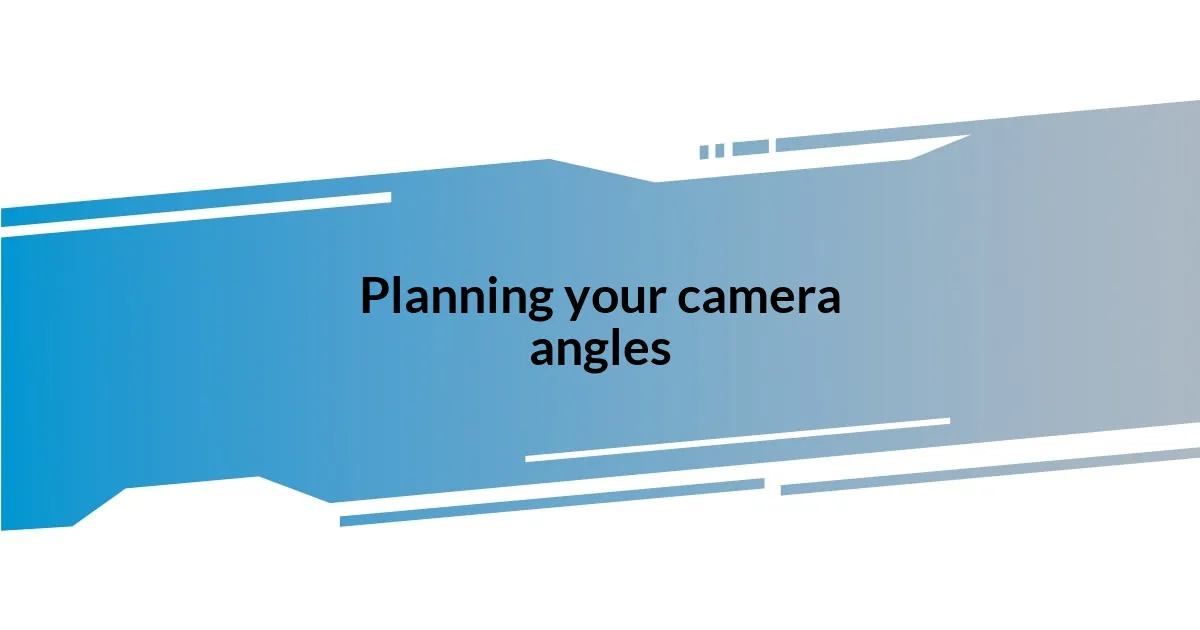
Planning your camera angles
When planning your camera angles, I’ve found that visualization is key. I often sketch out the scene to see how different angles work together, considering where the action will take place. Surprisingly, this simple step has helped me avoid overlooking some of the best opportunities for capturing genuine emotion in the moment.
One thing I learned the hard way is the importance of strategic angles. During a project, I set up a camera too far away, thinking it would capture the whole scene. However, it ended up lacking the intimacy I wanted because it couldn’t show the subtle reactions on people’s faces. Make sure you balance wide shots with close-ups; it creates a richer narrative flow that truly resonates with viewers.
I also recommend thinking about your audience’s perspective. Imagine what they want to see and how the camera can bring that to life. During a recent live performance, I positioned a camera at eye level with the performers, which really highlighted their expressions. It felt rewarding to see the audience connect more deeply with the moment simply because I paid attention to the angle.
| Camera Angle Type | Purpose |
|---|---|
| Wide Shot | Sets up the scene, shows environment and context |
| Close-Up | Highlights emotions and details |
| Over-the-Shoulder | Creates intimacy and perspective |
| High Angle | Conveys vulnerability |
| Low Angle | Conveys power and dominance |
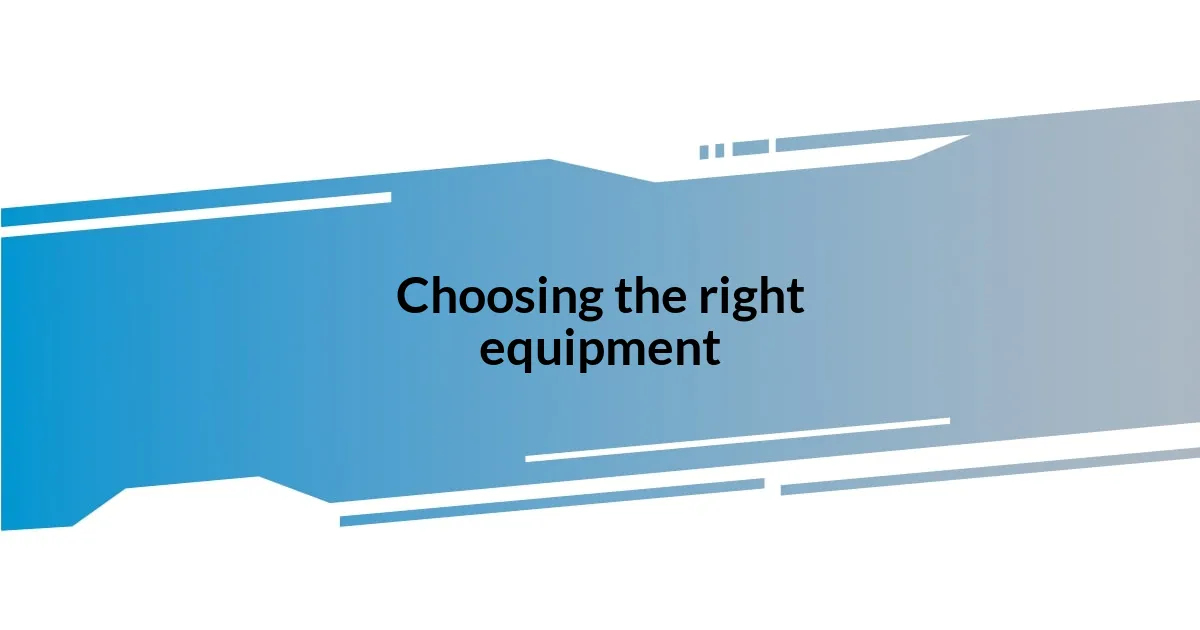
Choosing the right equipment
Choosing the right equipment is fundamental to achieving the best results with a multi-camera setup. I remember when I first started, I invested in a couple of decent webcams, thinking that would suffice. However, I quickly realized that having the right type of camera makes a world of difference. The clarity, color accuracy, and frame rate can either elevate or hinder the quality of your production.
Here are some key factors to consider when selecting your equipment:
- Camera Quality: Look for cameras that offer at least 1080p resolution for crisp image quality.
- Lenses: Depending on your needs, consider lenses with varying focal lengths to cover different perspectives.
- Tripods/Stabilizers: Ensure your equipment is steady; shaky footage can detract from the viewing experience.
- Audio Equipment: Don’t overlook sound; invest in good microphones to capture clear audio, as poor sound can ruin an otherwise great video.
- Switching Equipment: A reliable video switcher helps you manage multiple feeds seamlessly during production.
Reflecting on my journey, I remember being excited about a project where I used a mix of DSLRs and action cameras. Initially, I thought all cameras would yield similar results, but due to varying lenses and settings, they produced quite different footage. This taught me that consistency across your gear is essential if you want a cohesive final product. Balancing the technical specifications with personal creative vision is vital—don’t shy away from experimenting to find the right match for your unique filming style.

Setting up the cameras
Setting up the cameras requires a blend of technical precision and artistic vision. In my experience, ensuring proper alignment and framing is crucial. When I set up my last project, I spent extra time calibrating the cameras, checking the horizons, and ensuring that the focal points matched my artistic vision. This attention to detail paid off, making my footage look polished and intentional.
Another aspect I absolutely prioritize is the distance between the cameras. I once made the mistake of placing two cameras too close together during a shoot. It resulted in awkward overlapping fields of view, which not only confused the audience but also made post-production a nightmare. Now, I always take the time to optimize camera positioning, allowing each lens to tell its own story while still contributing to the overarching narrative. Have you ever dealt with camera overlap? It’s a headache I now avoid meticulously!
I also suggest considering lighting when setting your cameras. In one shoot, I forgot to account for harsh shadows, which ended up rendering some of my footage unusable. Positioning cameras where they not only capture the action but also benefit from favorable lighting dramatically elevates the final product. Placement isn’t just about capturing the scene; it’s about ensuring the environment works harmoniously with your setup.
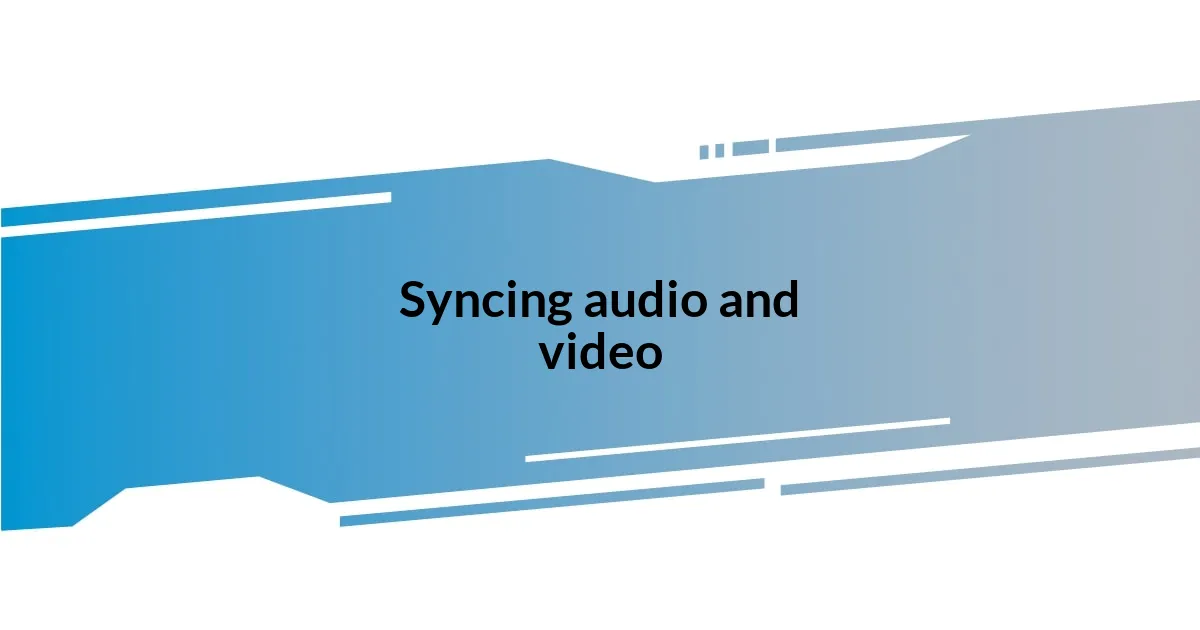
Syncing audio and video
Syncing audio and video can often feel like an intricate dance, but with just a few strategies, it becomes much more manageable. One method I frequently use is to clap loudly at the beginning of a recording. This simple act creates a distinct spike on both the audio and video tracks, making it easy to align them later. Have you tried this technique? It’s surprisingly effective and adds a touch of fun to the setup process!
In my early days, I once struggled to sync audio and video from different devices. I remember spending hours in post-production trying to manually align the tracks, which was both tedious and frustrating. Now, I always ensure to record audio using dedicated microphones instead of relying solely on the camera’s built-in mic. This not only improves sound quality but also allows for easier syncing through software like Adobe Premiere or Final Cut Pro, where I can visually match the audio waveform with the visual cue.
Furthermore, I prioritize using timecode when filming with multiple cameras. When I had a project where multiple angles were essential, incorporating timecode made the editing process smoother than I ever anticipated. Getting all the cameras synced to the same timecode saved me countless hours in post. Have you considered investing in timecode systems? They might seem like a hassle upfront, but trust me—they’re worth every penny for seamless integration!
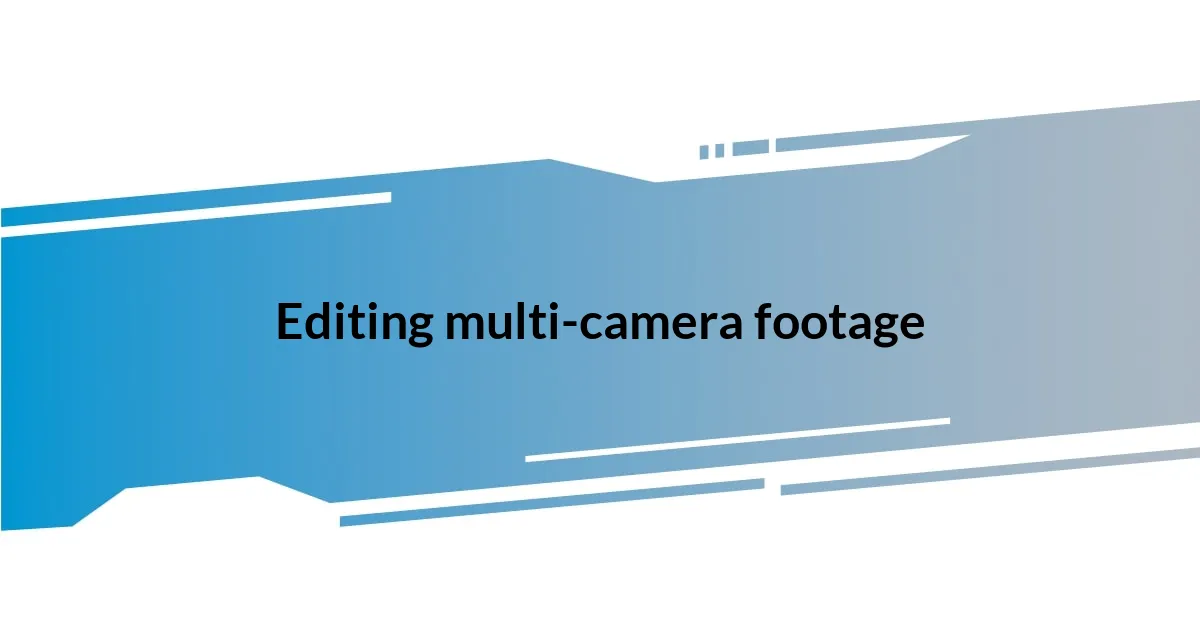
Editing multi-camera footage
Editing multi-camera footage can initially seem daunting, but it truly opens up a world of creativity. During one of my projects, I realized that having multiple angles allowed me to craft a dynamic story, ensuring every important moment was captured. Have you ever felt like a scene came alive when you switched angles? That’s the magic of multi-camera editing!
When it comes to the actual editing process, I find it vital to start with a solid timeline organization. I usually label my clips clearly and use color coding for easy identification. During a recent edit, I learned that this simple practice saved me from frustration—I could effortlessly pull up the desired angle without wasting time hunting through a messy timeline. Does getting organized before diving in resonate with anyone else?
Finally, I embrace the power of creative transitions. There was a time when I felt compelled to stick with straight cuts, but experimenting with fades and wipes transformed my projects significantly. In one memorable edit, using a smooth fade when shifting from one camera to another gave a sense of continuity that truly enhanced the storytelling. So, are you ready to explore transitions in your own work? Trust me, your audience will appreciate the extra layer of polish.
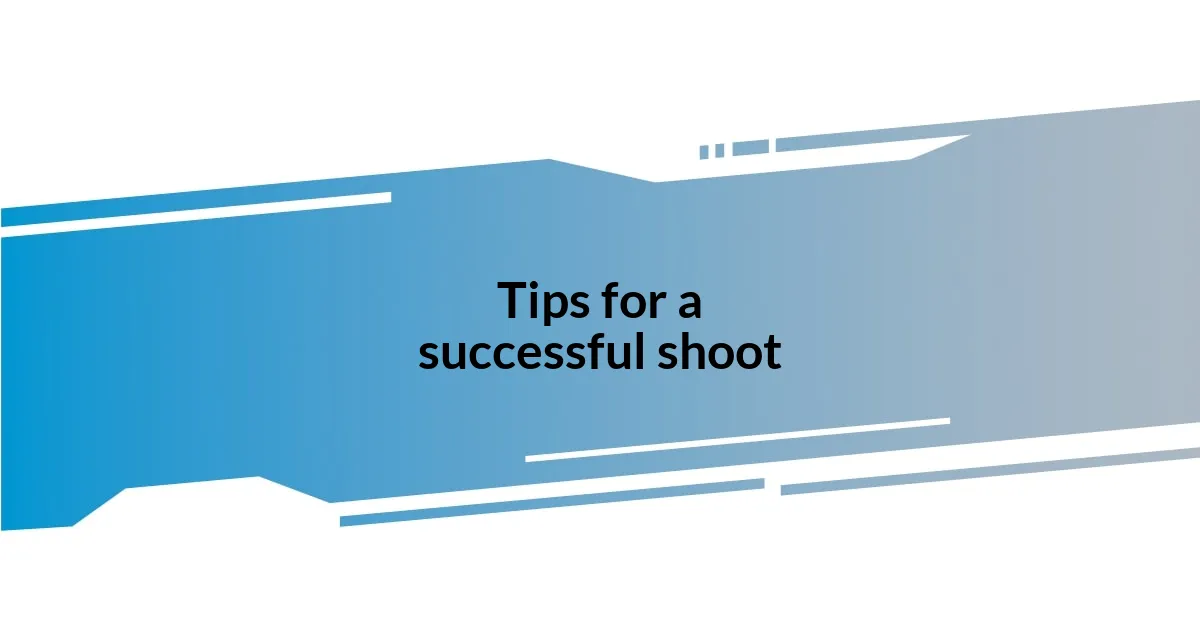
Tips for a successful shoot
When planning a shoot, I cannot stress enough the importance of good communication with your team. Once, during a larger production, I found myself frantically waving my arms to signal a camera change because we hadn’t established clear signals beforehand. Trust me, a simple pre-shoot meeting to discuss cues can save you a lot of confusion and keep everyone aligned on the vision. Have you found that taking the time to connect with your crew helps avoid hiccups during shooting?
Additionally, always scout your locations ahead of time. I remember a shoot where I hadn’t fully explored the space, and on the day of filming, I was blindsided by unexpected lighting issues. By visiting locations earlier, I could test angles and think about potential challenges. Have you ever been caught off guard by a location? I’ve learned that a little planning makes a world of difference in producing high-quality footage.
Lastly, make sure to allow for flexibility in your shooting schedule. Early in my career, I was too rigid with my timeline and missed some incredible spontaneous moments. Now, I schedule buffer time for unplanned events or creative exploration. Capturing those genuine, unscripted moments can elevate your project tremendously. How about you—do you embrace the surprises that come with filming? I find they often lead to the most memorable shots.